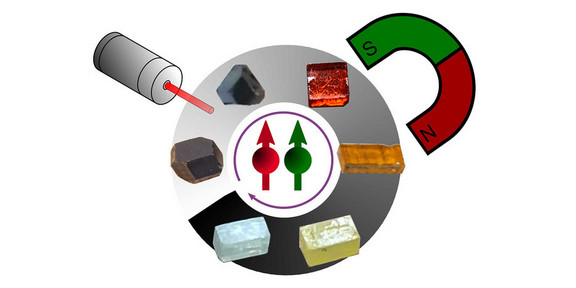Physicists control magnetic properties of perovskite materials
- News
- Research

Perovskites have been studied for more than 150 years. Recently, they have attracted a great deal of attention, as it has been possible to develop solar cells based on them that are similarly efficient to conventional silicon solar cells. Perovskites are also promising as a material for light sources such as light-emitting diodes. They are particularly attractive to industry because they can be produced flexibly and inexpensively.
The team led by the Dortmund physicists has now also investigated the suitability of these novel materials for other applications. To this end, their sensitivity to magnetic fields was tested, which is relevant, for example, for spin resonance phenomena such as those used in magnetic resonance imaging. The researchers were particularly interested in the spins of electrons, because the so-called g-factor of a spin is crucial for the coupling strength to a magnetic field. If this g-factor can be precisely adjusted, it is possible to influence the magnetic properties of a material.
The g-factor can be precisely adjusted
In the published work, the g-factor of charge carriers such as electrons was studied for lead-halogen perovskites with very different compositions. Perovskites based on lead-halogen compounds are semiconductors characterized by a so-called band gap. A band gap corresponds to a range of energies that electrons cannot occupy. The existence of the band gap is critical to the success of semiconductors in traditional electronics or optoelectronics because it makes the materials reliable in their operation and insensitive to interference.
To find out how g-factor and bandgap are related, the team used a wide variety of laser spectroscopic techniques in the magnetic field. This showed that g-factors and the band gaps are strongly correlated, so that a universal dependence could be derived for the entire variety of materials in the perovskites. This dependence provides very useful information for further research and material development: If one knows the band gap for a certain perovskite material, the g-factors can now be reliably predicted. Or the other way around: If one wants to achieve a certain g-factor, one only has to pick out the material with the corresponding band gap.
could do. This dependence provides very useful information for further research and material development: If one knows the band gap for a certain perovskite material, the g-factors can now be reliably predicted. Or the other way around: if one wants to achieve a certain g-factor, one only has to pick out the material with the corresponding band gap.
To the paper Nature Communications 13, 3062 (1-8) (2022)
Contact for queries:









